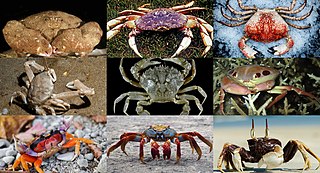
Crabs are decapod crustaceans of the infraorder Brachyura, which typically have a very short projecting tail-like abdomen, usually hidden entirely under the thorax. They live in all the world's oceans, in freshwater, and on land. They are generally covered with a thick exoskeleton. They generally have five pairs of legs, and they have pincer claws on the ends of the frontmost pair. They first appeared during the Jurassic period, around 200 million years ago.

The Decapoda or decapods are an order of crustaceans within the class Malacostraca, and includes crabs, lobsters, crayfish, shrimp, and prawns. Most decapods are scavengers. The order is estimated to contain nearly 15,000 extant species in around 2,700 genera, with around 3,300 fossil species. Nearly half of these species are crabs, with the shrimp and Anomura including hermit crabs, porcelain crabs, squat lobsters making up the bulk of the remainder. The earliest fossils of the group date to the Devonian.

King crabs are decapod crustaceans of the family Lithodidae that are chiefly found in deep waters and are adapted to cold environments. They are composed of two subfamilies: Lithodinae, which tend to inhabit deep waters, are globally distributed, and comprise the majority of the family's species diversity; and Hapalogastrinae, which are endemic to the North Pacific and inhabit exclusively shallow waters. King crabs superficially resemble true crabs but are generally understood to be closest to the pagurid hermit crabs. This placement of king crabs among the hermit crabs is supported by several anatomical peculiarities which are present only in king crabs and hermit crabs, making them a prominent example of carcinisation among decapods. Several species of king crabs, especially in Alaskan and southern South American waters, are targeted by commercial fisheries and have been subject to overfishing.

Reptantia is a clade of decapod crustaceans named in 1880 which includes lobsters, crabs and many other well-known crustaceans.
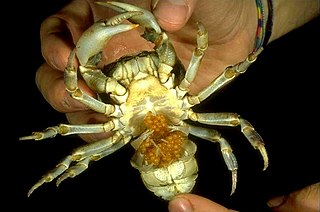
Pleocyemata is a suborder of decapod crustaceans, erected by Martin Burkenroad in 1963. Burkenroad's classification replaced the earlier sub-orders of Natantia and Reptantia with the monophyletic groups Dendrobranchiata (prawns) and Pleocyemata. Pleocyemata contains all the members of the Reptantia, as well as the Stenopodidea, and Caridea, which contains the true shrimp.
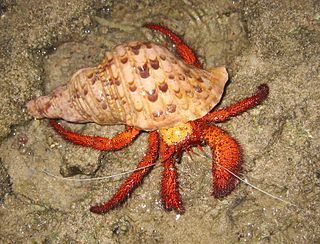
Anomura is a group of decapod crustaceans, including hermit crabs and others. Although the names of many anomurans include the word crab, all true crabs are in the sister group to the Anomura, the Brachyura.

Carcinisation is a form of convergent evolution in which non-crab crustaceans evolve a crab-like body plan. The term was introduced into evolutionary biology by L. A. Borradaile, who described it as "the many attempts of Nature to evolve a crab".

Astacidea is an infraorder of decapod crustaceans including lobsters, crayfish, and their close relatives.

Raninoida is a taxonomic section of the crabs, containing a single superfamily, Raninoidea. This group of crabs is unlike most, with the abdomen not being folded under the thorax. It comprises 46 extant species, and nearly 200 species known only from fossils.

Eucarida is a superorder of the Malacostraca, a class of the crustacean subphylum, comprising the decapods, krill, and Angustidontida. They are characterised by having the carapace fused to all thoracic segments, and by the possession of stalked eyes.
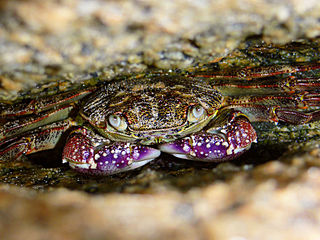
Thoracotremata is a clade of crabs, comprising those crabs in which the genital openings in both sexes are on the sternum, rather than on the legs. It comprises 17 families in four superfamilies .

The Grapsoidea are a superfamily of crabs; they are well known and contain many taxa which are terrestrial (land-living), semiterrestrial, or limnic. Another well-known member with a more conventional lifestyle is the Chinese mitten crab, Eriocheir sinensis.
Cyclodorippoida is a group of crabs, ranked as a section. It contains the single superfamily Cyclodorippoidea, which holds three families, Cyclodorippidae, Cymonomidae and Phyllotymolinidae.

Homoloidea is a superfamily of dromiacean crabs. Homoloidea belongs the group Dromiacea, taxonomically ranked as a section, and is the sister group to Dromioidea. Dromiacea is the most basal grouping of Brachyura crabs, and likely diverged from the rest of Brachyura around the Late Triassic or Early Jurassic. The close relation between Homoloidea and Dromioidea is primarily established through ultrastructural characteristics of the sperm.

Dromioidea is a superfamily of crabs mostly found in Madagascar. Dromioidea belongs the group Dromiacea, taxonomically ranked as a section, which is the most basal grouping of Brachyura crabs. Dromiacea likely diverged from the rest of Brachyura around the Late Triassic or Early Jurassic, and the earliest fossils attributable to the Dromioidea date from the Late Jurassic.

Podotremata is a traditionally used section of crabs (Brachyura), now considered to be invalid. It was the smaller grouping of crabs, separate from the larger Eubrachyura section. Morphological and molecular analyses do not reveal a monophyletic Podotremata, but rather that it is paraphyletic, and so the most recent classifications divide "Podotremata" into three sections: Dromiacea, Cyclodorippoidea and Raninoida.

Polychelida is an infraorder of decapod crustaceans. Fossil representatives are known dating from as far back as the Upper Triassic. A total of 38 extant species, all in the family Polychelidae, and 55 fossil species have been described.
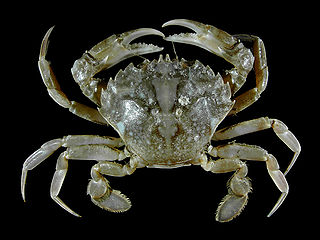
Eubrachyura is a group of decapod crustaceans comprising the more derived crabs. It is divided into two subsections, based on the position of the genital openings in the two sexes. In the Heterotremata, the openings are on the legs in the males, but on the sternum in females, while in the Thoracotremata, the openings are on the sternum in both sexes. This contrasts with the situation in other decapods, in which the genital openings are always on the legs. Heterotremata is the larger of the two groups, containing the species-rich superfamilies Xanthoidea and Pilumnoidea and all the freshwater crabs. The eubrachyura is well known for actively and constantly building its own burrows. The fossil record of the Eubrachyura extends back to the Cretaceous; the supposed Bathonian representative of the group, Hebertides jurassica, ultimately turned out to be Cenozoic in age.

Heterotremata is a clade of crabs, comprising those crabs in which the genital openings are on the sternum in females, but on the legs in males. It comprises 68 families in 28 superfamilies.

Eocarcinus praecursor is a Jurassic species of decapod crustacean, sufficiently distinct from its relatives to be placed in its own family (Eocarcinidae). Often considered the oldest true crab, it was considered by a 2010 study to be an early member of the Anomura. However, a reanalysis in 2020 again found it to be the earliest known stem-group crab.




















